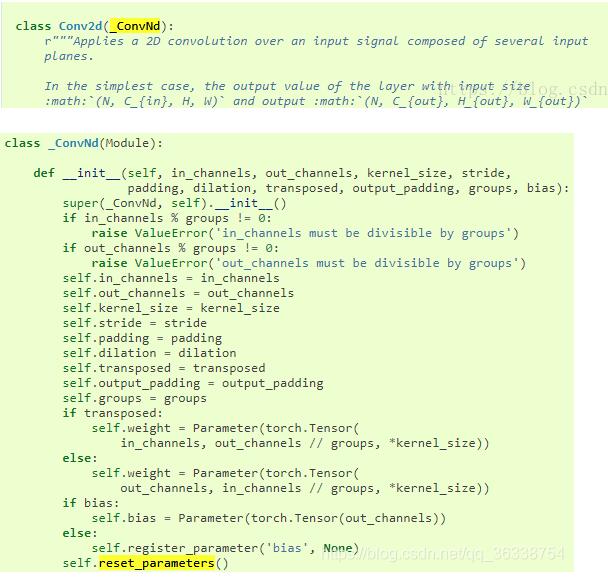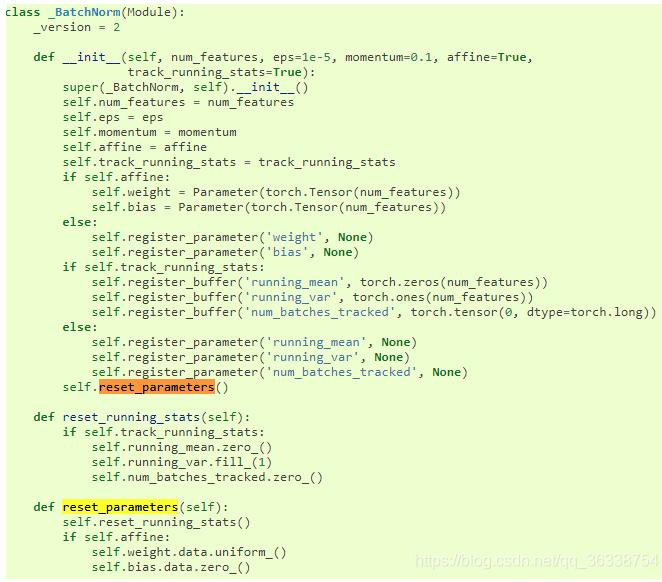您好,登錄后才能下訂單哦!
您好,登錄后才能下訂單哦!
怎么在Pytorch 中對TORCH.NN.INIT 參數進行初始化?很多新手對此不是很清楚,為了幫助大家解決這個難題,下面小編將為大家詳細講解,有這方面需求的人可以來學習下,希望你能有所收獲。
初始化函數:torch.nn.init
# -*- coding: utf-8 -*-
"""
Created on 2019
@author: fancp
"""
import torch
import torch.nn as nn
w = torch.empty(3,5)
#1.均勻分布 - u(a,b)
#torch.nn.init.uniform_(tensor, a=0.0, b=1.0)
print(nn.init.uniform_(w))
# =============================================================================
# tensor([[0.9160, 0.1832, 0.5278, 0.5480, 0.6754],
# [0.9509, 0.8325, 0.9149, 0.8192, 0.9950],
# [0.4847, 0.4148, 0.8161, 0.0948, 0.3787]])
# =============================================================================
#2.正態分布 - N(mean, std)
#torch.nn.init.normal_(tensor, mean=0.0, std=1.0)
print(nn.init.normal_(w))
# =============================================================================
# tensor([[ 0.4388, 0.3083, -0.6803, -1.1476, -0.6084],
# [ 0.5148, -0.2876, -1.2222, 0.6990, -0.1595],
# [-2.0834, -1.6288, 0.5057, -0.5754, 0.3052]])
# =============================================================================
#3.常數 - 固定值 val
#torch.nn.init.constant_(tensor, val)
print(nn.init.constant_(w, 0.3))
# =============================================================================
# tensor([[0.3000, 0.3000, 0.3000, 0.3000, 0.3000],
# [0.3000, 0.3000, 0.3000, 0.3000, 0.3000],
# [0.3000, 0.3000, 0.3000, 0.3000, 0.3000]])
# =============================================================================
#4.全1分布
#torch.nn.init.ones_(tensor)
print(nn.init.ones_(w))
# =============================================================================
# tensor([[1., 1., 1., 1., 1.],
# [1., 1., 1., 1., 1.],
# [1., 1., 1., 1., 1.]])
# =============================================================================
#5.全0分布
#torch.nn.init.zeros_(tensor)
print(nn.init.zeros_(w))
# =============================================================================
# tensor([[0., 0., 0., 0., 0.],
# [0., 0., 0., 0., 0.],
# [0., 0., 0., 0., 0.]])
# =============================================================================
#6.對角線為 1,其它為 0
#torch.nn.init.eye_(tensor)
print(nn.init.eye_(w))
# =============================================================================
# tensor([[1., 0., 0., 0., 0.],
# [0., 1., 0., 0., 0.],
# [0., 0., 1., 0., 0.]])
# =============================================================================
#7.xavier_uniform 初始化
#torch.nn.init.xavier_uniform_(tensor, gain=1.0)
#From - Understanding the difficulty of training deep feedforward neural networks - Bengio 2010
print(nn.init.xavier_uniform_(w, gain=nn.init.calculate_gain('relu')))
# =============================================================================
# tensor([[-0.1270, 0.3963, 0.9531, -0.2949, 0.8294],
# [-0.9759, -0.6335, 0.9299, -1.0988, -0.1496],
# [-0.7224, 0.2181, -1.1219, 0.8629, -0.8825]])
# =============================================================================
#8.xavier_normal 初始化
#torch.nn.init.xavier_normal_(tensor, gain=1.0)
print(nn.init.xavier_normal_(w))
# =============================================================================
# tensor([[ 1.0463, 0.1275, -0.3752, 0.1858, 1.1008],
# [-0.5560, 0.2837, 0.1000, -0.5835, 0.7886],
# [-0.2417, 0.1763, -0.7495, 0.4677, -0.1185]])
# =============================================================================
#9.kaiming_uniform 初始化
#torch.nn.init.kaiming_uniform_(tensor, a=0, mode='fan_in', nonlinearity='leaky_relu')
#From - Delving deep into rectifiers: Surpassing human-level performance on ImageNet classification - HeKaiming 2015
print(nn.init.kaiming_uniform_(w, mode='fan_in', nonlinearity='relu'))
# =============================================================================
# tensor([[-0.7712, 0.9344, 0.8304, 0.2367, 0.0478],
# [-0.6139, -0.3916, -0.0835, 0.5975, 0.1717],
# [ 0.3197, -0.9825, -0.5380, -1.0033, -0.3701]])
# =============================================================================
#10.kaiming_normal 初始化
#torch.nn.init.kaiming_normal_(tensor, a=0, mode='fan_in', nonlinearity='leaky_relu')
print(nn.init.kaiming_normal_(w, mode='fan_out', nonlinearity='relu'))
# =============================================================================
# tensor([[-0.0210, 0.5532, -0.8647, 0.9813, 0.0466],
# [ 0.7713, -1.0418, 0.7264, 0.5547, 0.7403],
# [-0.8471, -1.7371, 1.3333, 0.0395, 1.0787]])
# =============================================================================
#11.正交矩陣 - (semi)orthogonal matrix
#torch.nn.init.orthogonal_(tensor, gain=1)
#From - Exact solutions to the nonlinear dynamics of learning in deep linear neural networks - Saxe 2013
print(nn.init.orthogonal_(w))
# =============================================================================
# tensor([[-0.0346, -0.7607, -0.0428, 0.4771, 0.4366],
# [-0.0412, -0.0836, 0.9847, 0.0703, -0.1293],
# [-0.6639, 0.4551, 0.0731, 0.1674, 0.5646]])
# =============================================================================
#12.稀疏矩陣 - sparse matrix
#torch.nn.init.sparse_(tensor, sparsity, std=0.01)
#From - Deep learning via Hessian-free optimization - Martens 2010
print(nn.init.sparse_(w, sparsity=0.1))
# =============================================================================
# tensor([[ 0.0000, 0.0000, -0.0077, 0.0000, -0.0046],
# [ 0.0152, 0.0030, 0.0000, -0.0029, 0.0005],
# [ 0.0199, 0.0132, -0.0088, 0.0060, 0.0000]])
# =============================================================================補充:【pytorch參數初始化】 pytorch默認參數初始化以及自定義參數初始化
本文用兩個問題來引入
1.pytorch自定義網絡結構不進行參數初始化會怎樣,參數值是隨機的嗎?
2.如何自定義參數初始化?
在pytorch中,有自己默認初始化參數方式,所以在你定義好網絡結構以后,不進行參數初始化也是可以的。
1.Conv2d繼承自_ConvNd,在_ConvNd中,可以看到默認參數就是進行初始化的,如下圖所示


2.torch.nn.BatchNorm2d也一樣有默認初始化的方式

3.torch.nn.Linear也如此

pytorch中對神經網絡模型中的參數進行初始化方法如下:
from torch.nn import init #define the initial function to init the layer's parameters for the network def weigth_init(m): if isinstance(m, nn.Conv2d): init.xavier_uniform_(m.weight.data) init.constant_(m.bias.data,0.1) elif isinstance(m, nn.BatchNorm2d): m.weight.data.fill_(1) m.bias.data.zero_() elif isinstance(m, nn.Linear): m.weight.data.normal_(0,0.01) m.bias.data.zero_()
首先定義了一個初始化函數,接著進行調用就ok了,不過要先把網絡模型實例化:
#Define Network model = Net(args.input_channel,args.output_channel) model.apply(weigth_init)
此上就完成了對模型中訓練參數的初始化。
在知乎上也有看到一個類似的版本,也相應的貼上來作為參考了:
def initNetParams(net): '''Init net parameters.''' for m in net.modules(): if isinstance(m, nn.Conv2d): init.xavier_uniform(m.weight) if m.bias: init.constant(m.bias, 0) elif isinstance(m, nn.BatchNorm2d): init.constant(m.weight, 1) init.constant(m.bias, 0) elif isinstance(m, nn.Linear): init.normal(m.weight, std=1e-3) if m.bias: init.constant(m.bias, 0) initNetParams(net)
1.保存有兩種方式,第一種是保存模型的整個結構信息和參數,第二種是只保存模型的參數
#保存整個網絡模型及參數 torch.save(net, 'net.pkl') #僅保存模型參數 torch.save(net.state_dict(), 'net_params.pkl')
2.加載對應保存的兩種網絡
# 保存和加載整個模型
torch.save(model_object, 'model.pth')
model = torch.load('model.pth')
# 僅保存和加載模型參數
torch.save(model_object.state_dict(), 'params.pth')
model_object.load_state_dict(torch.load('params.pth'))看完上述內容是否對您有幫助呢?如果還想對相關知識有進一步的了解或閱讀更多相關文章,請關注億速云行業資訊頻道,感謝您對億速云的支持。
免責聲明:本站發布的內容(圖片、視頻和文字)以原創、轉載和分享為主,文章觀點不代表本網站立場,如果涉及侵權請聯系站長郵箱:is@yisu.com進行舉報,并提供相關證據,一經查實,將立刻刪除涉嫌侵權內容。